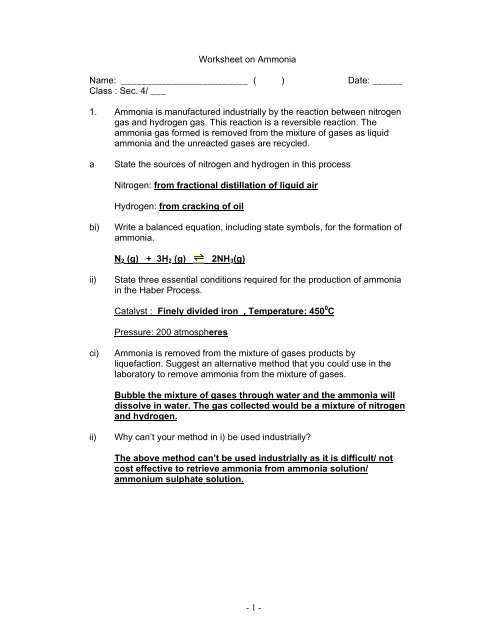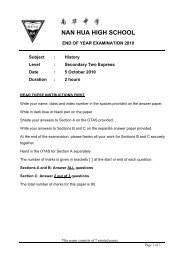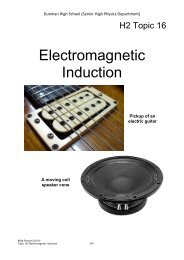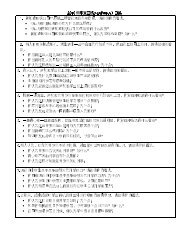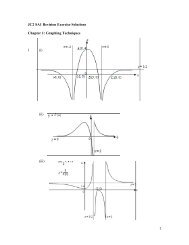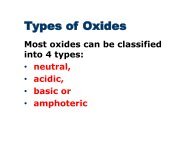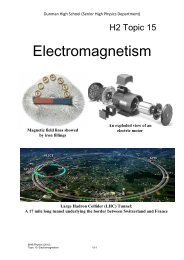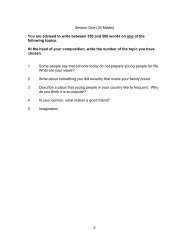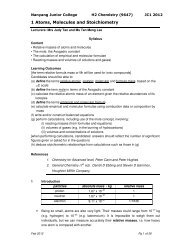Worksheet on Ammonia Name: ( ) Date - ASKnLearn
Worksheet on Ammonia Name: ( ) Date - ASKnLearn
Worksheet on Ammonia Name: ( ) Date - ASKnLearn
- No tags were found...
You also want an ePaper? Increase the reach of your titles
YUMPU automatically turns print PDFs into web optimized ePapers that Google loves.
<str<strong>on</strong>g>Worksheet</str<strong>on</strong>g> <strong>on</strong> Amm<strong>on</strong>ia<strong>Name</strong>: _________________________ ( ) <strong>Date</strong>: ______Class : Sec. 4/ ___1. Amm<strong>on</strong>ia is manufactured industrially by the reacti<strong>on</strong> between nitrogengas and hydrogen gas. This reacti<strong>on</strong> is a reversible reacti<strong>on</strong>. Theamm<strong>on</strong>ia gas formed is removed from the mixture of gases as liquidamm<strong>on</strong>ia and the unreacted gases are recycled.aState the sources of nitrogen and hydrogen in this processNitrogen: from fracti<strong>on</strong>al distillati<strong>on</strong> of liquid airHydrogen: from cracking of oilbi)Write a balanced equati<strong>on</strong>, including state symbols, for the formati<strong>on</strong> ofamm<strong>on</strong>ia.N 2 (g) + 3H 2 (g)2NH 3 (g)ii)State three essential c<strong>on</strong>diti<strong>on</strong>s required for the producti<strong>on</strong> of amm<strong>on</strong>iain the Haber Process.Catalyst : Finely divided ir<strong>on</strong> , Temperature: 450 0 CPressure: 200 atmospheresci)Amm<strong>on</strong>ia is removed from the mixture of gases products byliquefacti<strong>on</strong>. Suggest an alternative method that you could use in thelaboratory to remove amm<strong>on</strong>ia from the mixture of gases.Bubble the mixture of gases through water and the amm<strong>on</strong>ia willdissolve in water. The gas collected would be a mixture of nitrogenand hydrogen.ii)Why can’t your method in i) be used industrially?The above method can’t be used industrially as it is difficult/ notcost effective to retrieve amm<strong>on</strong>ia from amm<strong>on</strong>ia soluti<strong>on</strong>/amm<strong>on</strong>ium sulphate soluti<strong>on</strong>.- 1 -
2 The table below shows the percentage yield of amm<strong>on</strong>ia at varioustemperatures and pressures.Temperature(°C)Pressure(atm)350 100 38350 200 53350 300 62400 100 25400 200 38400 300 48450 100 17450 200 27450 300 36500 100 12500 200 20500 300 26Percentage Yield(%)ai)State how pressure and temperature affect the yield in amm<strong>on</strong>ia.Pressure: The higher the pressure, the higher the yieldTemperature: The higher the temperature, the lower the yieldii)A chemical engineer designs a reacti<strong>on</strong> chamber that can support atemperature of 450°C and a pressure of 250 atm. Estimate thepercentage yield of amm<strong>on</strong>ia under such c<strong>on</strong>diti<strong>on</strong>s.27% < amm<strong>on</strong>ia yield < 36%b) To further speed up the reacti<strong>on</strong>, a catalyst is used. <strong>Name</strong> the catalystand suggest, with explanati<strong>on</strong>, what may be d<strong>on</strong>e to the catalyst toenhance its effectiveness.Finely divided ir<strong>on</strong> catalystIt increases the surface area which increases the rate of reacti<strong>on</strong>c) The yield of amm<strong>on</strong>ia in the Haber Process is low, compared with otherindustrial reacti<strong>on</strong>s. Explain why this is so.The yield of amm<strong>on</strong>ia in the Haber Process is low due to thereacti<strong>on</strong> being reversible – some of the products re-form thereactants at the same time, and hence it is not possible to allowthe all the reactants to turn into products.- 2 -
d) Calculate the mass of amm<strong>on</strong>ia obtained when 56 t<strong>on</strong>nes of nitrogen isused, assuming that the percentage yield is <strong>on</strong>ly 15%.N 2 (g) + 3 H 2 (g)2 NH 3 (g)No. of moles of nitrogen = 56 x 10 6 / 14x2= 2 x 10 6No. of moles of amm<strong>on</strong>ia = 2 ( 2 x 10 6 )Mass of amm<strong>on</strong>ia = 15/100 x ( 4 x 10 6 ) x (14 + 3 )= 10.2 x 10 6 g= 10.2 t<strong>on</strong>nes ( 3 s.f.)3) Amm<strong>on</strong>ia is manufactured in the Haber Process. The following graphshows the amount of amm<strong>on</strong>ia present in the equilibrium mixture underc<strong>on</strong>diti<strong>on</strong>s of temperature and pressure.a) Use the graph to deduce the effect of increasing the pressure <strong>on</strong> thepercentage of amm<strong>on</strong>ia in the equilibrium mixture.Increasing the pressure increase the percentage of amm<strong>on</strong>ia in theequilibrium mixture.b) An industrial process uses c<strong>on</strong>diti<strong>on</strong>s of 450 0 C and 200 atm.i) Use the graph to find the percentage of amm<strong>on</strong>ia in the equilibriummixture.27% or 28%ii)Suggest <strong>on</strong>e advantage and <strong>on</strong>e disadvantage of using 450 0 C ratherthan 350 0 C as the working temperature.Advantage: Faster rate of reacti<strong>on</strong>Disadvantage: Less percentage of amm<strong>on</strong>ia in equilibriummixture.- 3 -
iii)A student has three test-tubes of gas. One tube c<strong>on</strong>tains amm<strong>on</strong>ia, <strong>on</strong>ec<strong>on</strong>tains hydrogen and <strong>on</strong>e c<strong>on</strong>tains nitrogen. Describe tests thestudent could do to identify the three gases.Moist red litmus papers are placed near the mouth of the 3 testtubes.The gas that turns the moist red litmus blue is amm<strong>on</strong>ia.For the remaining two test-tubes of gases, place , a lighted splint atthe mouth of the test-tubes. The gas which extinguishes thelighted splint with a ‘pop’ sound is Hydrogen. The remaining gasmust be nitrogen gas as it does not give positive results to these 2tests.4. Amm<strong>on</strong>ia is used to manufacture nitric acid, by a two-stage process.Stage 1: the amm<strong>on</strong>ia is c<strong>on</strong>verted to nitrogen (II) oxide.4NH 3 (g) + 5O 2 (g) → 4NO (g) + 6 H 2 OH = - 950kJ/mola) State and explain how the rate changes when the pressure isincreased. Use ideas about colliding particles.As the pressure increases, the molecules are forced closertogether, increasing the number of collisi<strong>on</strong> and successfulcollisi<strong>on</strong>s. Hence, increasing the rate of reacti<strong>on</strong>.b) During the reacti<strong>on</strong>, the amm<strong>on</strong>ia and oxygen are passed through apowdered catalyst.i) Explain why the catalyst becomes hot during the reacti<strong>on</strong>.It is an exothermic reacti<strong>on</strong>.ii)Explain why the catalyst is used in the form of powder.Catalyst in the form of powders have greater surface area. Henceincreasing the rate of reacti<strong>on</strong>c) It is possible to find out whether this reacti<strong>on</strong> has finished by followingpH changes during the reacti<strong>on</strong>. Samples of gas are taken from thereacti<strong>on</strong> vessel at intervals and bubbled through water to form asoluti<strong>on</strong>. The pH of each soluti<strong>on</strong> is measured. Explain why themeasured pH changes during the reacti<strong>on</strong>.The pH decreases because amm<strong>on</strong>ia which is alkaline is beingused up.- 4 -
Stage 2: the nitrogen dioxide is c<strong>on</strong>verted to nitric acid.4NO(g) + 2H 2 O (g) + 3O 2 (g) → 4HNO 3 (aq)d) Calculate the maximum mass of nitric acid which can be made from720 dm 3 of nitrogen (II) oxide, NO, at room temperature and pressure.No. of moles of NO = 72024= 30No. of moles of HNO 3 = 30Mass of HNO 3 = 30 x (1 + 14 + 3 x 16)= 1890 g ( 3 s.f.)e) Use the two equati<strong>on</strong>s to c<strong>on</strong>struct an overall equati<strong>on</strong> for thec<strong>on</strong>versi<strong>on</strong> of amm<strong>on</strong>ia to nitric acid.simplify add the right hand side of the equati<strong>on</strong>s together and lefthand side of the equati<strong>on</strong>s together and simplify.4NH 3 + 5O 2 + 4NO + 2H 2 O + 3O 2 → 4HNO 3 + 4NO + 6H 2 O4NH 3 + 8O 2 → 4HNO 3 + 4H 2 ONH 3 + 2O 2 → HNO 3 + H 2 O (divide throughout by 4)5 a) amm<strong>on</strong>iab) Soluti<strong>on</strong> X is alkalinec) Calcium chloride2Cl - + Ca 2+ → CaCl 2d) 2NH 4 Cl + Ca(OH) 2 → CaCl 2 + 2NH 3 + 2H 2 O6 a) Moist red litmus paper turned blue and then red again.Explain your answer.Amm<strong>on</strong>ium chloride decomposes up<strong>on</strong> heating to form amm<strong>on</strong>ia andhydrogen chloride gas. Amm<strong>on</strong>ia gas having a lower relative molecularmass (17) diffuses at a faster rate than hydrogen chloride gas (36.5)turning the moist red litmus blue. Hydrogen chloride gas diffuses out ofthe test tube slower and hence turning the moist blue litmus red again.b) State <strong>on</strong>e other observati<strong>on</strong> she would make. Explain thisobservati<strong>on</strong>White sublimate observed. Amm<strong>on</strong>ia gas and hydrogen gas will recombinefurther up the test-tube where is cooler to form amm<strong>on</strong>iumchloride which is seen as a white sublimate- 5 -


